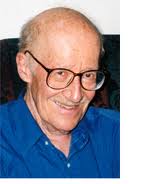Obituary for Arthur Nowick
 Arthur S. Nowick died on July 20 at age 86 of heart arrhythmia while swimming near his home in Newport Beach, California. He was a pioneer in the field of internal friction, anelasticity, and crystal defects.
Arthur S. Nowick died on July 20 at age 86 of heart arrhythmia while swimming near his home in Newport Beach, California. He was a pioneer in the field of internal friction, anelasticity, and crystal defects.
He is the author of more than 200 publications in a wide range of fields in materials science and solid-state physics. His 1972 book "Anelastic Relaxation in Crystalline Solids," coauthored with Brian S. Berry, is widely recognized at the definitive treatise on internal friction and anelasticity. He is author of the 1995 book "Crystal Properties via Group Theory." He is coeditor of two additional books on diffusion in solids. He was also Ph.D. advisor to nearly 30 students.
Dr. Nowick was the 1994 recipient of the David Turnbull Lectureship, bestowed by the MRS in recognition of career contributions to the fundamental understanding of the science of materials. The award cited his "pioneering work in anelastic and dielectric behavior in fast ion conductors, and in amorphous alloys," his "profound contributions to the understanding of grain boundary motion, morphological stability, the structure of surfaces and interfaces, and flow and diffusion as stochastic phenomena," and "his excellence in teaching and writing." His Turnbull Award Lecture, titled "The Golden Age of Crystal Defects," elucidated the emergence of an understanding of crystal defects and explained his seminal contributions and those of his collaborators.
Dr. Nowick also received the Achievement Award from the American Society for Metals (1963), the A. Frank Golick Lectureship from the University of Missouri, Rolla (1970), and the Gold Medal from the 9th International Conference on Internal Friction and Ultrasonic Attenuation in Solids (1989). He was a Fellow of the American Physical Society and of the Metallurgical Society of AIME. In 1987 he received the Great Teacher Award from Columbia University.
Dr. Nowick received his bachelor's degree in Physics from Brooklyn College in 1943 and his master's and Ph.D. degrees from Columbia University in 1948 and 1950. From 1949-1951 he was a postdoctoral fellow with Clarence Zener at the University of Chicago.
He began his professional career in 1951 as an Assistant, and then Associate, Professor of Metallurgy at Yale University. In 1957, he moved to head the metallurgy group at the new IBM T. J. Watson Research Center. In 1966, Dr. Nowick accepted a position at Columbia University and spent the main part of his career as a Professor of Metallurgy and Materials Science at Columbia University in the Henry Krumb School of Mines, which ultimately became part of the School of Engineering and Applied Science. At the time of his retirement to emeritus status in 1993, he held the Henry Marion Howe Professorship. In 2001, he moved to California, where he held a position of Visiting Researcher in the Department of Chemical Engineering and Materials Science at the University of California, Irvine, until the time of his death.
Dr. Nowick was esteemed by his former students, colleagues, and members of the scientific community. Professor Harry L. Tuller, of the Department of Materials Science and Engineering at MIT, comments: "I was one of Art's doctoral students at Columbia graduating in 1973 and until today, nearly 40 years later, I still appreciate his influence on my academic training, my research and my teaching. He was a wonderful role model. What is more, I can honestly say that my present career path, as faculty member at MIT, was directly due to his advice and support."
Professor Irving P. Herman, Chair of the Department of Applied Physics and Applied Mathematics, and Director of the Materials Research Science and Engineering Center, at Columbia University, recalls his interactions: "When I arrived at Columbia in 1986, Art Nowick was one of the clear leaders in the materials science effort. He also led the Committee on Solid State Science and Engineering, which bound together the efforts in several departments on campus. Since then, solid state and materials physics has been flourishing at Columbia, in part to Art's interdepartmental leadership. I interacted with him many times in this effort, and always found him to be a wise and very kind person." Professor Richard M. Osgood, Jr., Higgins Professor of Electrical Engineering and Applied Physics at Columbia University, adds: "When I joined Columbia, he was carrying out beautiful experiments showing the physics of ion-mediated conductivity in glass. He also managed to hold together the vision of Columbia's commitment to high-quality, physics-based materials science. He was a real standout in the materials community: a great scientist and a terrific person."
Professor Martin E. Glicksman, Florida 21st Century Scholar in the Department of Materials Science & Engineering at the University of Florida and member of the National Academy of Engineering, remarks: " I've known him for almost 50 years, and admired greatly his works at Columbia University. The world has lost a truly great human being." Professor Theodore Moustakas, of the Departments of Electrical and Computer Engineering and Physics and Director of the Wide Bandgap Semiconductor Laboratory at Boston University, concludes: "Art's care and guidance has truly shaped my professional career. I wish I had the chance to tell him this before he departed."
In addition to being an outstanding materials scientist, Dr. Nowick was also an accomplished pianist, with wide-ranging interests in classical music and jazz. His friends, colleagues and students often enjoyed his in-home concerts.
Dr. Nowick is survived by his wife of 60 years Joan; their sons Jon, Steve, Alan, and James; his sons' respective spouses Pauline, Martha, Irene, and John; and his grandson Jordan.
